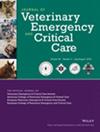Management of a Nondeflating Foley Urinary Catheter Balloon by Transrectal Centesis in a Dog
Abstract
Objective
To describe the management of a nondeflating urinary catheter balloon via transrectal centesis in a dog and to propose an algorithm for the nonsurgical management of this adverse event in dogs.
Case Summary
A mature neutered male crossbreed dog presented with a <24-h history of acute paraplegia secondary to a T13–L1 hydrated nucleus pulposus extrusion. During placement of an indwelling urinary catheter, the Foley balloon reservoir was inadvertently inflated in the proximal urethra. Initial attempts to deflate the balloon through aspiration of the inflation channel, transection of the inflation channel proximal to the inflation valve, and insertion of the stylet into the inflation channel to remove potential obstructions were unsuccessful. The balloon reservoir was successfully deflated by transrectal centesis using a 22-gauge needle. No short- or long-term complications were associated with this procedure.
New or Unique Information Provided
Nondeflation is a relatively infrequent complication of urinary catheterization using a Foley catheter. Causes include faulty valve mechanisms, obstruction of the inflation channel, or crystallization of fluid within the balloon. This report describes the use of transrectal centesis to deflate a balloon reservoir lodged in the proximal urethra of a male dog. This technique has not previously been reported. An algorithm for the nonsurgical management of nondeflating Foley catheters in dogs is also proposed.


 求助内容:
求助内容: 应助结果提醒方式:
应助结果提醒方式:


